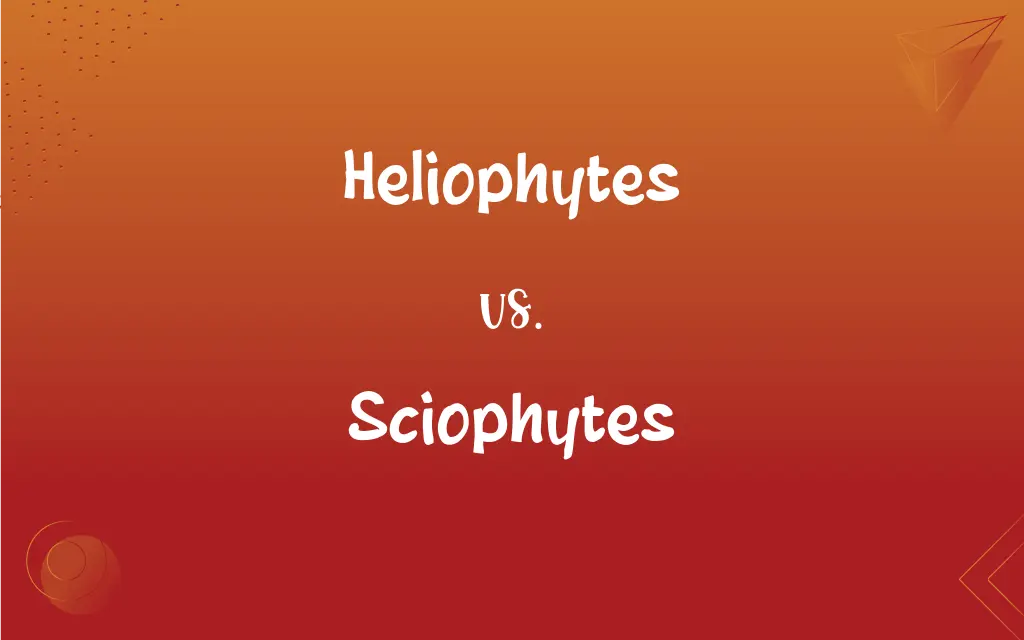Heliophytes vs. Sciophytes: What's the Difference?
Edited by Aimie Carlson || By Janet White || Published on January 16, 2024
Heliophytes are plants that thrive in full sunlight, whereas sciophytes are plants adapted to grow in shaded or low-light environments.

Key Differences
Heliophytes are adapted to environments with abundant sunlight, possessing features like smaller, thicker leaves to reduce water loss. In contrast, sciophytes typically have larger, thinner leaves, maximizing light absorption in low-light conditions.
The growth of heliophytes is optimal in open areas like grasslands and sunny edges of forests, where sunlight is plentiful. Sciophytes, however, are commonly found in forest understories and densely shaded areas where sunlight is scarce.
Heliophytes often exhibit rapid growth and high photosynthetic rates in bright light conditions, making them suited for sunny habitats. Sciophytes, on the other hand, have slower growth rates and are adapted to photosynthesize efficiently in dim light.
Many heliophytes show adaptations such as sunken stomata and reflective leaf surfaces to cope with intense sunlight. In contrast, sciophytes often have thin, broad leaves to capture as much light as possible in their shaded environments.
Heliophytes are typically found in environments that experience less competition for light, such as open fields, while sciophytes are adapted to compete for the limited light available in densely forested or shaded areas.
ADVERTISEMENT
Comparison Chart
Preferred Light Condition
Thrive in full sunlight
Grow in shaded or low-light areas
Leaf Characteristics
Smaller, thicker leaves
Larger, thinner leaves
Typical Habitats
Open areas like grasslands, sunny forest edges
Forest understories, densely shaded areas
Growth and Photosynthesis
Rapid growth, high photosynthetic rates in bright light
Slower growth, efficient photosynthesis in dim light
Adaptations
Sunken stomata, reflective surfaces
Thin, broad leaves for maximum light absorption
ADVERTISEMENT
Heliophytes and Sciophytes Definitions
Heliophytes
Plants that require abundant sunlight for optimal growth and development.
Lavender, a heliophyte, flourishes in the sunny Mediterranean climate.
Sciophytes
Plants adapted to grow in shaded or low-light conditions.
Ferns, as sciophytes, thrive in the dappled shade of the forest floor.
Heliophytes
Flora that are suited for environments where sunlight is not a limiting factor.
Many heliophytes, like daisies, dominate meadows and open fields.
Sciophytes
Flora typically found in densely forested areas where they compete for light.
Many sciophytes, like certain orchids, are found in tropical rainforests.
Heliophytes
Sun-loving plants with features to reduce water loss and handle intense light.
Cacti are heliophytes, thriving in the desert's intense sunlight.
Sciophytes
Shade-tolerant plants with larger leaves to maximize light absorption.
Hostas are sciophytes, flourishing in the shady areas of gardens.
Heliophytes
Plants adapted to and flourishing in high sunlight environments.
Sunflowers are classic heliophytes, growing best in open, sunny fields.
Sciophytes
Organisms that are efficient at photosynthesizing in dim light conditions.
The sciophytes in my backyard garden grow well despite the tall trees casting shade.
Heliophytes
Organisms that have evolved to capitalize on environments with plentiful sunlight.
The heliophytes in my garden bloom profusely in the summer sun.
Sciophytes
Plants that have evolved to survive in environments with limited sunlight.
The sciophytes in the dense woodland understory rarely see direct sunlight.
Heliophytes
Plural of heliophyte
Sciophytes
Plural of sciophyte
FAQs
Do heliophytes need a lot of water?
They are generally more drought-resistant due to their adaptations.
Where are heliophytes commonly found?
In open, sunny environments like grasslands and clearings.
What defines a sciophyte?
A sciophyte is a plant adapted to grow in shaded or low-light areas.
Can sciophytes thrive in full sunlight?
Sciophytes are adapted for shade and may suffer in intense sunlight.
What defines a heliophyte?
A heliophyte is a plant that is adapted to and thrives in environments with high sunlight.
Can heliophytes grow in shade?
Heliophytes prefer sunlight and may not grow optimally in shaded conditions.
What are typical heliophyte adaptations?
They often have smaller, thicker leaves and sunken stomata to reduce water loss.
Where do sciophytes typically grow?
In shaded areas like forest understories and dense woodlands.
What are typical sciophyte characteristics?
They usually have larger, thinner leaves to absorb more light.
Do sciophytes have special soil requirements?
They often thrive in rich, moist soils typical of forested areas.
Can sciophytes adapt to brighter environments?
They may adapt to some extent but generally prefer low-light conditions.
Is it possible to have a garden of mixed heliophytes and sciophytes?
Yes, by carefully planning the garden layout according to light availability.
Are all desert plants heliophytes?
Most desert plants are heliophytes, but there are exceptions.
Are sciophytes important for biodiversity?
Yes, they play a crucial role in shaded ecosystems and support unique flora and fauna.
Are sciophytes slower growers than heliophytes?
Generally, yes, due to lower light levels affecting their photosynthesis rate.
How do heliophytes contribute to their ecosystem?
They often form the primary producers in sunny ecosystems, supporting diverse wildlife.
Can heliophytes be used for xeriscaping?
Yes, many heliophytes are ideal for water-efficient landscaping.
How do heliophytes manage water loss?
Through adaptations like waxy leaf surfaces and reduced leaf area.
Do heliophytes require special care in gardens?
They need ample sunlight and well-drained soil but are often low maintenance.
Do sciophytes need protection from strong winds?
Yes, their thinner leaves can be more susceptible to wind damage.
About Author
Written by
Janet WhiteJanet White has been an esteemed writer and blogger for Difference Wiki. Holding a Master's degree in Science and Medical Journalism from the prestigious Boston University, she has consistently demonstrated her expertise and passion for her field. When she's not immersed in her work, Janet relishes her time exercising, delving into a good book, and cherishing moments with friends and family.
Edited by
Aimie CarlsonAimie Carlson, holding a master's degree in English literature, is a fervent English language enthusiast. She lends her writing talents to Difference Wiki, a prominent website that specializes in comparisons, offering readers insightful analyses that both captivate and inform.






































































